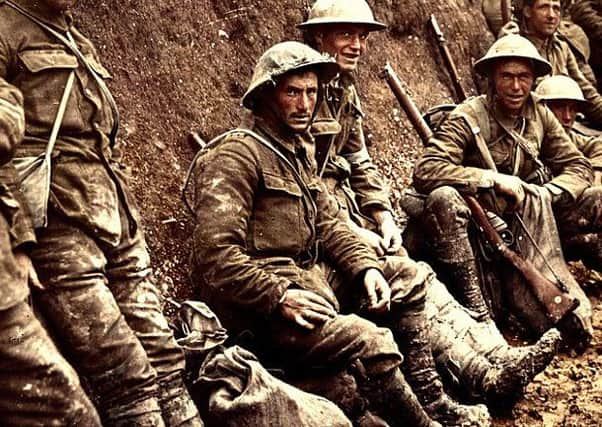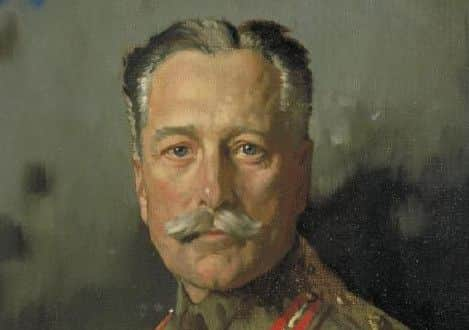Battle of Somme wasn't a disaster '“ it laid the foundations to win WWI


Under the heavy, snow-filled skies of Picardy one hundred years ago this month the Battle of the Somme drew to a close after 141 days.
The four-and-a-half month battle is often viewed as an unmitigated disaster. Between July 1 and mid-November 1916 the British sustained 432,000 casualties, approximately 3,060 for every day of the battle.
Advertisement
Hide AdAdvertisement
Hide AdAs G H Gretton observed in 1930, ‘No one who lived through that time will ever forget the casualty lists of the Somme.’


It was undeniably a human tragedy but was it all futile?
Certainly the territorial gains made for such horrendous casualties were modest: approximately a 10 km advance on a front 35 km long.
David Lloyd George who became prime minster in December 1916, had no doubts. He regarded the Somme as ‘a ghastly failure’.
Douglas Haig, the commander of the British Expeditionary Force, on the other hand, offered a justification of the Somme campaign in a despatch dated December 23 1916 which was published in The Times a week later. He wrote: “The objective of [the] offensive was threefold:
Advertisement
Hide AdAdvertisement
Hide Ad

1. To relieve the pressure on [the hard-pressed French at] Verdun.
2. To assist our allies in other theatres by stopping any further transfer of German troops from the Western front [to the Eastern or Italian fronts].
3. To wear down the strength of the forces opposed to us.”
He concluded by claiming all three objects had been achieved and observing: ‘Any one of these results is in itself sufficient to justify the Somme battle. The attainment of all three of them affords ample compensation for the splendid efforts of our troops and for the sacrifices made by ourselves and our Allies. They have brought us a long step forward towards the final victory of the Allied cause.’
Haig’s first assertion – that he had relieved the pressure on Verdun – was perfectly fair.
Advertisement
Hide AdAdvertisement
Hide AdIt is impossible to stand over his second assertion – that he had assisted his allies in other theatres by stopping any further transfer of German troops from the Western front – because the Germans were still able to send troops to the Eastern front to bolster Austria-Hungary and to contain the stunningly successful Russian offensive conducted by Alexei Brusilov. Without German aid Austria-Hungary might well have collapsed. Furthermore, the Germans were able to overrun Romania, which had rashly entered the war on the Allied side because of the early success of the Brusilov offensive.
The third assertion – that he had succeeded in wearing down the strength of the enemy – is the most difficult of Haig’s three assertions to evaluate.
One way of doing so is to pose and answer two key questions: What did the Germans say after the Somme? And, more importantly, what did the Germans do?
Captain von Hentig, a member of the general staff of the Guard Reserve Division and an officer who served on the Somme, was quite explicit and wrote:
Advertisement
Hide AdAdvertisement
Hide Ad‘The Somme was the muddy grave of the German field army and of the faith in the infallibility of German leadership, dug by British industry and its shells ... The German Supreme Command, which had entered the war with enormous superiority, was defeated by the superior techniques of its opponents. It had fallen behind in the application of destructive forces, and it was compelled to throw division after division without protection against them into the cauldron of the battle of annihilation.’
General Ludendorff, along with Field Marshal Hindenburg, was effective commander of the German army after August 1916. Ludendorff was not as explicit as Hentig but he did concede in his memoirs which appeared in 1919: ‘The fighting made the most extraordinary demands both on commanders and troops. Divisions and other formations had to be thrown in on the Somme front in quicker succession and had to stay in the line longer … The strain on our nerves was terrible; over and over again we had to find and adopt new expedients. In October the attacks continued in undiminished force, especially in the northern part of the front …’
Ludendorff conceded further that ‘we were completely exhausted on the western front ... If the war lasted our defeat seemed inevitable … I cannot see as I look back how the German GHQ could have mastered the situation if the Allies had continued their blows as they did in 1916’.
The British may not have broken the morale of the German army but they had succeeded in shaking German confidence in ultimate victory to its very core.
Advertisement
Hide AdAdvertisement
Hide AdThis is even more evident when we address the second question: what did the Germans do?
On December 12 1916 Germany and Austria-Hungary proposed that peace negotiations be begun through the representatives of Switzerland, the United States, and Spain. On December 20 President Wilson of the United States called upon Germany and Austria-Hungary to make their proposals more specific but they declined to do so. Ten days later the Allies rejected the proposals as unworthy of serious consideration. The significance of this usually overlooked episode is surely that the Germans were no longer confident of winning the war.
At a conference in January 1917 Germany decided to resume unrestricted submarine warfare. Despite the high risk of provoking United States entry into the war, Hindenburg endorsed the decision for this very telling reason: ‘We must save the men from a second Somme battle’.
Between February 21 and March 31 1917 the Germans made a tactical withdrawal to the 300-mile-long Siegfried Stellung (which the British called Hindenburg line), construction of which began as early as September 1916.
Advertisement
Hide AdAdvertisement
Hide AdThe decision to withdraw to the Hindenburg line was taken on February 4 1917 and was dictated by the imperative of avoiding another Somme, a further demonstration that the Somme was indeed a British victory.
Finally, in order to win the Materialschlacht – the battle to produce military hardware and munitions – the German economy was placed on a war footing which had not been necessary before the Somme. Hindenburg set a target of doubling the output of shells and tripling production of machine guns and artillery. Two new ministries were established to supervise the war economy and such manpower as was available was conscripted to work in munitions factories.
Turning to the British side of the equation, in Battle Tactics on the Western Front: The British Army’s Art of Attack (1994) the late Paddy Griffith charted the improvement in tactics which made the British Army the most formidable fighting machine in the world by the autumn of 1918. British tactics improved markedly after the first day of the Somme. Griffith contended that significant tactical reform was already evident by July 14. The British invented their own version of “storm troop tactics” at least as fast as the Germans did, and issued their official manual for modern infantry platoon attacks in February 1917.
Griffith correctly points out that historians ought not to concentrate on the “butchery and bungling” of the first two years of the Great War to the exclusion of second half of the conflict. The battles of ‘the last Hundred Days’ of 1918, beginning on August 8, the day which Ludendorff described as ‘The Black Day’ of the German Army, ought to be the brightest pages in the annals of British military history. Yet perversely those battles are almost wholly overlooked in the popular mind. And that great British military achievement, recounted by Peter Hart in 1918: A Very British Victory (2008), began with a learning curve which started on July 2 1916.
Advertisement
Hide AdAdvertisement
Hide AdThe Somme, in Paddy Griffith’s words, transformed the British Army ‘from a largely inexperienced army to a largely experienced one’.
Gary Sheffield in The Somme (2003) offers the following judicious assessment: ‘For the Allies, the Somme was not a “victory” in the traditional sense, but it was a success. Moreover it is difficult to avoid the conclusion that the Battle of the Somme was an essential precondition to the Allied victory of 1918… the Battle of the Somme was not a victory in itself but without it the Entente [the British and the French] would not have emerged victorious in 1918.’